Update – In November 2023, Douglas Original was discontinued for the US. However, it’s still available for purchase in Canada here.
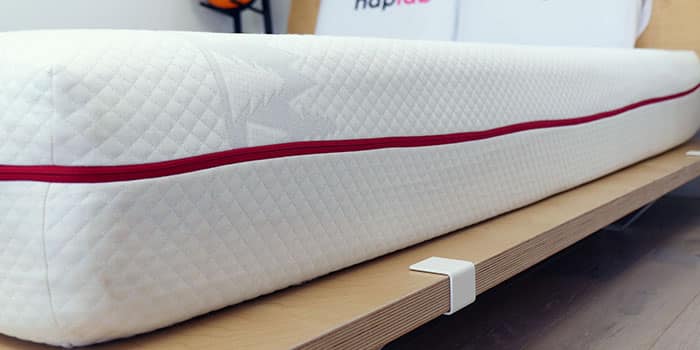
Best For
- Extremely low motion transfer and low bounce
- Excellent edge support, especially for a 100% foam mattress
- Removable cover (but not machine washable)
Considerations
- May not be supportive enough for heavyweight sleepers
- Low bounce may not be ideal for good sex
Our Verdict
The Douglas mattress is a foam mattress that uses a poly foam blend to make up its 10″ profile. This mattress has a firmness of 6 out of 10, which makes it a suitable firmness for a pretty wide range of sleepers.
In our performance tests, it had excellent cooling, minimal sinkage, extremely low motion transfer, very fast response time, very low bounce, excellent edge support, fair sex, and excellent pressure relief.
Douglas is only available in Canada.
Type: Poly Foam
Firmness: Medium Firm (6)
Best For: All Sleeping Positions, All Body Weights
In This Review
Performance Tests | Firmness | Support & Sleeping Positions | Design | Materials | Comparisons | FAQs
Performance Tests
At NapLab, we put each mattress to the test.
We test 10 different factors that impact the performance, comfort, and value of the mattress. We then take the results of that test and compare to every mattress we’ve tested to date.
Check out the full performance table below to see how this mattress ranks:
| Factor | Douglas | Average |
|---|---|---|
| Overall Score | 9.02 | 8.64 |
| Price (Queen) | C$799 | $1,095 (Foam only) |
| Cooling – Score | 9.0 | 8.8 |
| Sinkage – Depth | 1.83″ | 2.16″ |
| Sinkage – Feel | Minimal | Moderate |
| Motion Transfer – Score | 10 | 8.2 |
| Motion Transfer – Acceleration | 1.24 m/s² | 8.64 m/s² |
| Response Time – Score | 9.2 | 8.9 |
| Response Time – Mostly Recovered | 0.3 sec. | 0.4 sec. |
| Response Time – Fully Recovered | 0.7 sec. | 0.9 sec. |
| Bounce – Height | 5.21″ | 9.69″ |
| Bounce – Feel | Very Low | Moderate |
| Edge Support – Score | 9.4 | 8.6 |
| Edge Support – Sitting | 3.25″ | 4.07″ |
| Edge Support – Lying | Excellent | Good |
| Sex – Score | 7.0 | 8.5 |
| Pressure Relief – Score | 9.0 | 8.8 |
| Comfort Layer Thickness | 4.0″ | 4.2″ |
| Mattress Thickness | 10″ | 12.0″ |
| Off-Gassing – Score | 8.6 | 8.4 |
| Off-Gassing – Smell | Strong | Strong |
| Off-Gassing – Days | 5 days | 6 days |
| Company – Score | 9.3 | 8.7 |
| Trial | 365 nights | 165 nights |
| Warranty | 20 years | 25% have lifetime warranties, average of other 75% of mattresses is 14 years |
How is Douglas Different?
The Douglas mattress has above-average overall performance and a price that is impressively low—36% less than the average foam mattress.
Advantages
Advantages of this mattress include slightly better cooling than average and motion transfer levels that were 85% lower than average. Also, the price point can be a real selling point for many sleepers who are trying to stay within a tight budget.
Neutral Factors
Douglas has 16% less sinkage than average as well as 46% less bounce than average. Both of these factors are considered preferential factors and not really good vs. bad.
Disadvantages
The Douglas mattress is only 10″ thick, which could be a disadvantage for pressure relief, considering the average mattress thickness is nearly 2″ thicker (1.9″).

Cooling Test
Cooling performance on the Douglas mattress was excellent. During our tests, I did not feel any significant heat retention. The layers of foam seem to breathe well and keep sleepers comfortably cool.
Baseline Temp.
77.7° F
Max Temp.
88.0° F
Ending Temp.
79.7° F
Looking at our heat dissipation curve we see a significant decline from the 0 to 1-minute mark, with the temperature dropping from 88.0° F to 83.2. This is a drop of 4.8°F.
Max Temp.
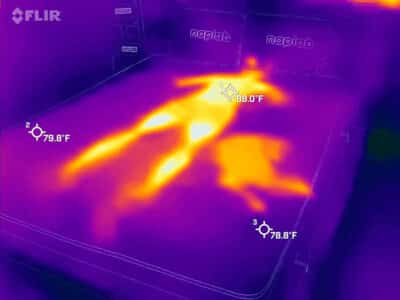
Ending Temp

- Baseline Temperature – the temperature of the mattress before anyone lies on it
- Maximum Temperature (0 minute) – the temperature of the mattress after lying on it for 15 minutes
- Ending Temperature (5 minute) – the temperature of the mattress after being lied upon and having no one on it for 5 minutes
Based on all of our temperature tests to date, on average, we see a decline of 3.9 degrees from 0 to 1 minutes, so the Douglas is notably better.
Heat dissipation continues over the 5-minute measurement period, with a final temperature of 79.7° F.
This is a total decline of 8.3°, nearly making it back to the baseline of 77.7°F. That said, I’m most pleased by the dissipation from 0 to 1 minute.
Heat Dissipation Over Time
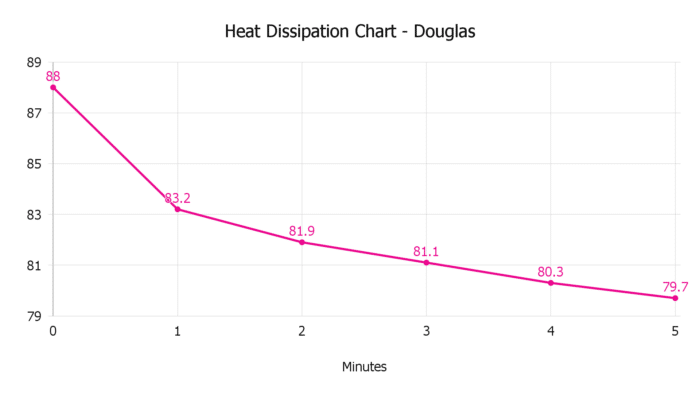
Within 1 minute 57.8% of the total heat dissipation over the 5-minute period is released.
This fact indicates that my subjective experience matches what we’re seeing with the objective data, a mattress that breathes well and releases heat.
Sinkage Test
The Douglas mattress has a minimal level of sinkage. In our tests, we measured just 1.83” of sinkage.
Sinkage Depth
1.83″
Sinkage Feel
Minimal
On average, across all of our mattress tests to date, we see a sinkage depth of 2.18”.
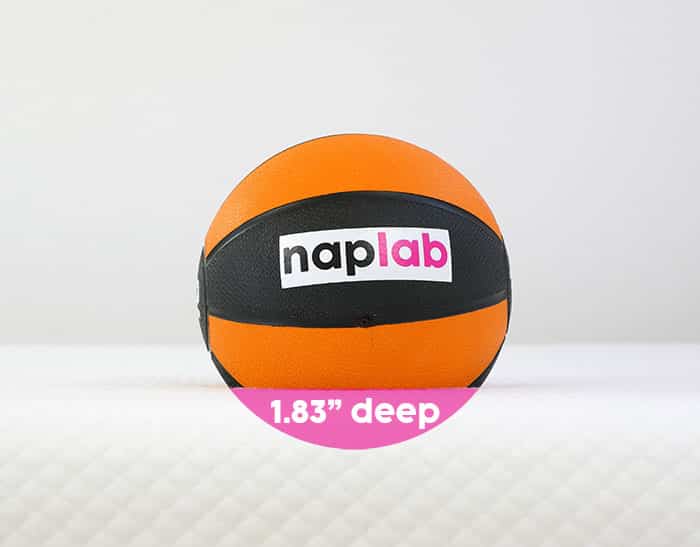
I was surprised by the restrained level of sinkage on the Douglas. Typically, medium firmness memory foam mattresses have a sinkage depth in the 2.0-2.4” range. The Douglas is quite a bit less.
Despite the more restrained sinkage depth I still felt plenty of pressure relief, contour, and hug. Having a little less sinkage may help to keep sleepers cooler, as you won’t feel as enveloped by layers of foam and fabric around your body.
Motion Transfer Test
Motion transfer on the Douglas mattress is extraordinarily low. In our tests, we measured just 1.24 m/s² of acceleration range.
This is the lowest motion transfer we have tested to date on any mattress.
The layers of foam, medium firmness, and thin cover all work together to create the absolute best motion isolation. As you can see from our videos there is essentially zero movement.
If you sleep with a partner who is easily disturbed by motion (or perhaps you are the partner) then the Douglas mattress can definitely help.
Max. Acceleration
0.6 m/s²
Min. Acceleration
-0.64 m/s²
Accel. Range
1.24 m/s²
In our motion transfer chart (which visualizes our accelerometer data), you can see that most of the high motion is finished by 0.21 seconds.
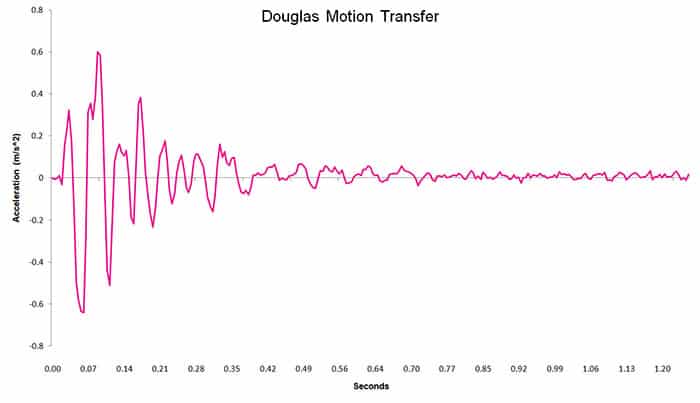
A moderate level of motion persists up until 0.35 seconds, before returning to near-zero levels. However, it’s important to note that the “high” and “moderate” levels of motion here are relative to the Douglas itself.
The peak motion transfer on the Douglas mattress is still massively less than almost every other mattress we’ve tested to date.
Response Test
The Douglas mattress has a very fast response time. In our tests, we measured a mostly recovered material response of 0.3 seconds and a full material recovery time of 0.7 seconds.
Mostly Recovered
0.3 sec.
Complete Recovery
0.7 sec.
On average, based on all of our mattress tests to date, we see mostly recovered times of 0.4 seconds and a full material recovery of 0.8 seconds.
Comparatively, the Douglas mattress is notably better than the average in both measurement categories.
The level of responsiveness is documented in the video below.
Based on the material construction, I was expecting the response to be a good bit slower.
The Douglas mattress uses a poly foam that has many of the benefits of memory foam, like hug, contour, and pressure relief, but with a faster response and better cooling.
These are all properties that you tend to see with latex and other high-performance poly foams.
This proprietary poly foam, in combination with the layer of Elastex in the core (another responsive poly foam), gives the Douglas a fast response time.
A faster response time makes it easier to move around on the mattress and helps sleepers never feel stuck.
Bounce Test
Bounce on the Douglas mattress is very low. In our tests, we measured a total bounce height of 5.21”. This is significantly lower than the average bounce based on all of our mattress tests to date, which is 9.30”.
Max. Depth
4.60″
Max. Rebound
0.61″
Total Bounce
5.21″
The relative softness of the Douglas, in combination with the 4.0” thick comfort layer, and motion dissipation properties create a mattress that kills most of the bounce.
Max. Sinkage Depth
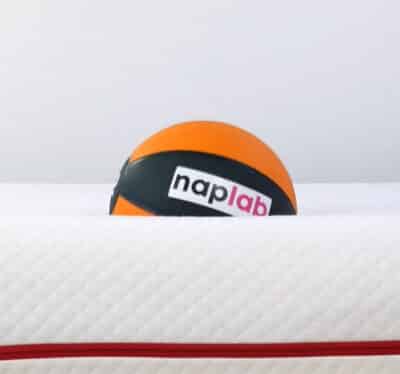
Max Bounce Height

The level of bounce is also documented in the video below.
While ultra-low bounce is great for low motion transfer, it also means less than great sex (more on that below) and a less-than-traditional feel.
In any case, bounce is more of a preferential factor. Some sleepers prefer more, others less. That said, without question, the Douglas would be classified as a mattress with a very low level of bounce.
Edge Support Test
The Douglas mattress has excellent edge support for both sitting and lying. In our sitting edge support tests, we measured just 3.25” of edge support compression.
This is notably better than the average (based on all of our mattress tests to date), which is 4.14”.
Max Sinkage
3.25″
Lying Support
Excellent
The Douglas does a nice job of remaining supportive even when sitting directly on the edge.
The level of edge support while seated is documented in the images below.
Sitting, 140 lbs.

Sitting, 200 lbs.

Edge support while lying on the mattress was equally as impressive. While lying directly on the edge of the mattress I felt well-supported in all 3 sleeping positions (even when wearing my 60-pound weighted vest).
The level of edge support while lying is documented in the images below.
Lying on Edge, 140 lbs.

Lying on Edge, 200 lbs.

The edge support speaks to the quality of the materials. Many lower-quality poly foams would see significantly worse edge support.
Typically, we only see edge support to this level on higher performance hybrid mattresses.
It’s great to see an all-foam mattress that can deliver the edge performance many sleepers desire.
Sex Test
The best mattresses for sex have high bounce, good edge support, quiet materials, and good pressure relief and cooling.
These 5 factors make up the NapLab sex performance score.
| Sex Factor | Factor Weight | Score | Rating |
|---|---|---|---|
| Bounce | 65% | 5.7 | Very Low |
| Edge Support | 20% | 9.7 | Excellent |
| Noise | 5% | 10 | Minimal |
| Pressure Relief | 5% | 9.0 | Excellent |
| Cooling | 5% | 9.0 | Excellent |
When we look at the factors that make up the overall sex score, we see some pros and cons. The biggest disadvantage for the Douglas is low levels of bounce.
Good bounce is an important factor for good sex and on the Douglas energy is absorbed and deadened. While this can be good for sleeping without disruption, it’s not really great the dance without pants.
Aside from low bounce, the Douglas offers good edge support, minimal noise, good pressure relief, and good cooling.
Pressure Relief Test
The Douglas mattress has excellent pressure relief. The mattress uses a 4.0” thick comfort layer of responsive poly foams.
Comfort Layer
4.0″
Support Layer
10″
The top layer of foam is designed to feel more like memory foam, while avoiding the negatives. And the middle layer is designed to feel more like natural latex (high response, good cooling, higher bounce).
The combination creates a high degree of hug and contour around sleeper bodies, while keeping motion to a minimum, bounce low, and response high.
The top layer in particular really does a nice job of creating a more exacting contouring hug around the body. It feels very similar to many other high-performance memory foam formulations I’ve tested over the years.
Overall, I felt a high degree of pressure relief in all sleeping positions. The Douglas is an incredibly comfortable mattress.
Off-Gassing Test
Off-gassing on the Douglas mattress is pretty strong, but nothing too off the charts.
Initial Smell Strength
Strong
Off-Gassing Period
5 days
The average length of time for mattress off-gassing is 2.87 days (based on all of our mattress tests to date). As you can see, the Douglas does take longer than that, about twice the length of time.
That being said, off-gassing is a process that happens on most foam mattresses. It can be a pain for the first couple of days, but once a mattress has off-gassed there should be no significant residual odor from the mattress.
To speed up the process, try to leave the mattress in a well-ventilated room without bedding or a mattress protector on it.
Company
The company score takes a look at factors that may influence your experience with the mattress.
Factors include length of the trial period, warranty, shipping / return costs, and country of origin.
| Company Factor | Factor Weight | Score | Data |
|---|---|---|---|
| Trial Period | 15% | 10 | 365 nights |
| Warranty | 10% | 8.0 | 20 years |
| Shipping | 5% | 10 | $0 |
| Returns | 20% | 10 | $0 |
| Trust | 50% | 9.0 | Excellent |
| Country of Origin | 0% | Canada |
The Douglas mattress is manufactured by GoodMorning.com, the same company that makes other brands like Novosbed, Logan & Cove, and others.
As a company, GoodMorning.com offers a 365-night trial period and a 15-year warranty for all of its mattresses.
The head office for the company is located in Canada, but all of their mattresses sold in the US are also manufactured in the US, at a factory located in Pennsylvania.
How firm is the Douglas mattress?
The Douglas mattress is a 6 out of 10 on the firmness scale, where 10 is the most firm.

Support & Sleeping Positions
Since this mattress is a medium firmness, it is suitable for essentially all sleepers. It is firm enough to provide support, while still being soft enough for good hug and contour for lighter sleepers.
| Sleeper Weight | Stomach Sleepers | Side Sleepers | Back Sleepers |
|---|---|---|---|
| Under 150 lbs. | Yes | Yes | Yes |
| 150-250 lbs. | Yes | Yes | Yes |
| 250-300 lbs. | No | No | No |
I will note here that the manufacturer actually puts a weight limit cap at 250 lbs. per side on the Douglas mattress. Due to its thinner profile of only 10″, this may not be a great option for heavier sleepers.
Design
The Douglas is a 100% foam mattress with three layers and a 10″ thickness. It has a medium firm feel and is designed to suit a wide range of sleeper preferences.
Type
Foam
Thickness
10″
Firmness
6
Aesthetically, this mattress has a white quilted cover with a simple bright red accent line across the middle of the mattress.

Materials
The inside materials include three layers of different types foam. From top to bottom, the layers are listed below:
- 2.0″ gel poly foam
- 2.0″ latex-like poly foam
- 6.0″ support foam
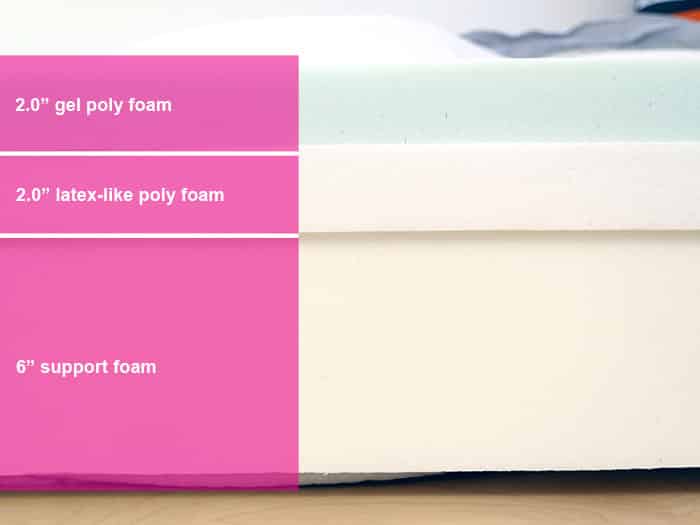
The Cover
The cover of the Douglas uses a soft, knitted material that includes Tencel.

The top of the cover actually zips off, which is a nice feature for cleaning, as needed.
The Comfort Layer
The comfort layer is made of two separate foam layers. On the top layer is a gel poly foam that is designed for better cooling and fast response time.
Below that layer is a latex-like poly foam. This secondary layer acts as a transition between the top comfort layer and the lower support layer.

The Support Layer
The support layer of the Douglas mattress is 6.0″ thick, which is a little thinner than we usually see and may not provide sufficient pressure relief for heavier sleepers.

This base foam is a 6″ thick support foam and acts as a foundational base.
Product Evolution
The Douglas mattress was first launched in 2017. Since its launch, there have been no material or design changes to the mattress.
These sizes include:
- RV Bunk Small: 28″W x 75″L x 10″H
- RV Three Quarter: 48″W x 75″L x 10″H
- RV Short Queen: 60″W x 75″L x 10″
Other Mattresses to Consider
Not sure if the Douglas mattress is right for you? Check out one of the three other mattress options below for highly-rated alternatives.
For More Bounce
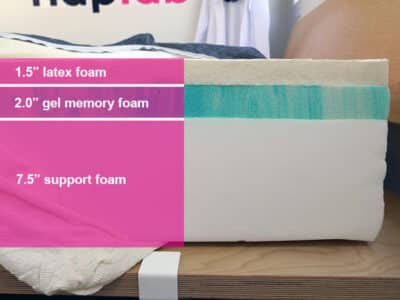
Ghostbed
8.76 Overall Score
The Ghostbed mattress has 3″ of comfort material made of latex foam and gel memory foam. This mattress has higher levels of bounce, which makes it better for and easier to move around on.
For Alternate Firmness
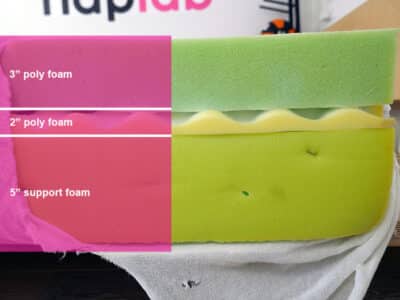
Nest Bedding Quail
9.04 Overall Score
The Nest Bedding Quail is another option with a 10″ profile. It uses 3″ of poly foam with a 2″ layer of convoluted poly foam. This mattress comes in two firmnesses, 5 out of 10 or 8 out of 10.
For Potential Savings
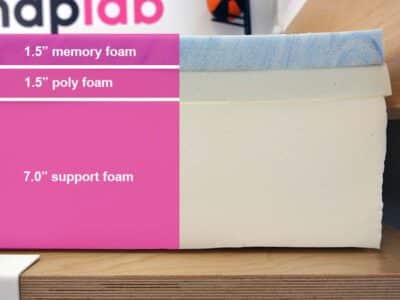
Leesa Studio
8.44 Overall Score
The Leesa Studio mattress has a 10″ profile with 3″ of comfort material and 7″ of support foam. This mattress is the budget pick from the Leesa lineup, which makes it a nice option for combo foam on a budget.
Frequently Asked Questions
Still have questions? Check out some of the top FAQs on the Douglas mattress below and get the answers you’re looking for.
The cost of a Douglas mattress varies depending on what size you’re looking for. Here are the current prices, with any sales or promotions reflected below:
Twin: $599
Twin XL: $629
Full: $679
Queen: $799
King: $899
Cal. King: $899
RV Bunk Small: $599
RV Three-Quarter: $699
RV Short Queen: $749
*Note: Sales prices are subject to change without notice or warning.
This mattress comes with a 15-year warranty so you can confidently expect the mattress to last at least that long.
Douglas is a 100% foam mattress, made of three separate foam layers—poly foam and support foam.
In our tests, I would recommend allowing the mattress to off-gas for the full 5 days before sleeping on it. But that being said, if you’re not sensitive to strong odors, you can sleep on it as soon as it arrives. It takes just a few minutes for the mattress to decompress from the box.
Both Endy and Douglas are 100% foam mattresses made in Canada. Douglas manufactures in facilities located in Toronto and Calgary and Endy has a home base in Ontario and Quebec. Despite their similarities, they offer a different feel. In addition, Douglas has a longer trial and warranty (365-night trial and 15-year warranty) over the Endy (100-night trial and 10-year warranty).
The Douglas mattress is 10″ thick.




